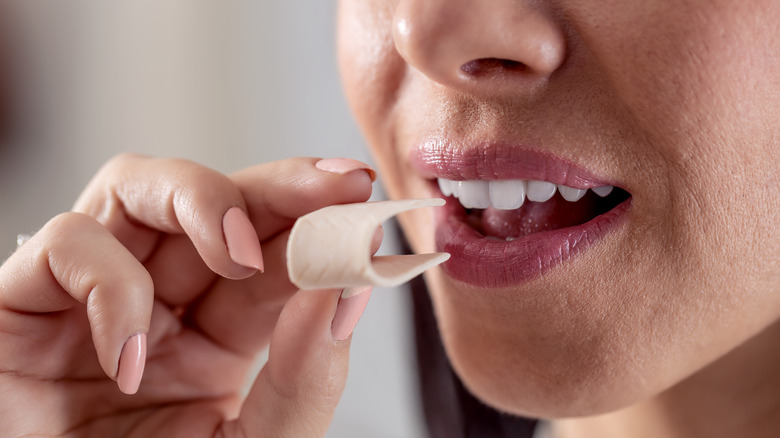Does Chewing Gum Really Help With A Toothache?
Pain in the teeth and mouth are common, with over 40% of adults reporting some mouth pain in the last year, according to the Centers for Disease Control and Prevention. Despite being prevalent, however, mouth pain shouldn't be ignored. Toothaches, in particular, can be a warning sign of oral health conditions, including tooth decay, infection, and damaged teeth or fillings (per Cleveland Clinic).
For serious pain that doesn't go away, a dentist may treat a toothache by prescribing an antibiotic, filling cavities in the case of tooth decay, removing affected teeth, or performing a root canal. For mild and temporary pain, relief can be found in over-the-counter and household products. Healthline suggests non-steroidal anti-inflammatory drugs (NSAIDs), acetaminophen, or medicated toothache gels and drops. A saltwater or hydrogen peroxide rinse, peppermint tea, and ice packs can also help in a pinch.
Chewing gum can be another easily accessible remedy for some kinds of toothache. However, the way it's used might not be what you would expect.
Chewing gum can relieve pain from a broken tooth
Chewing gum — as long as it's sugar-free gum — might benefit the teeth by increasing salivation and preventing cavities, says the American Dental Association. However, routinely chewing gum could cause pain in some cases. Dentist Dr. Karyn Kahn told Cleveland Clinic that munching on gum can cause headaches, jaw pain, and fractured teeth, especially for people who already have temporomandibular joint (TMJ) disorder. If you have a toothache, chewing gum might only make the pain worse. In fact, the National Health Service urges against chewing food of any kind with a sore tooth.
There is one way that gum could relieve a toothache, however. Oral health brand Colgate suggests covering a painful broken tooth in the mouth with chewing gum. The chewing gum protects the cheeks and tongue from the sharp edges of the remaining tooth while also preventing potential gum damage. This hack is only a short-term solution until you visit your dentist.
If you're still tempted to chew something to relieve a dull toothache, try a fresh clove of garlic instead of gum. Healthline explains that the pantry staple has antibacterial and antimicrobial properties that can alleviate tooth pain. Peel a clove, place it on the affected area, and gently chew. Then, let it remain on the tooth as it acts as a DIY pain-fighting paste.


